Abstract
Despite significant business-related research publications, extant studies are yet to show how well business research directly maps to 17 Sustainable Development Goals (SDGs). Our study uses a qual-quant approach combining the PRISMA framework, performance analysis, and content analysis to find answers to this research gap. Using the Australia Business Deans Council list of 2500+ journals as a proxy for business research during 2016–2022, our study shows that only about 25% of business research is directly mapping to SDGs with SDG 3 (Good Health and Well Being) and SDG 7 (Affordable and Clean Energy) being the most mapped. The most cited journals are the Journal of Cleaner Production, Applied Energy, and the European Journal of Public, which largely focus on SDG 7, SDG 13 (Climate Action), and SDG 3. Top authors focus their research mainly on SDG 7, SDG 13, and SDG 12 (Responsible Consumption and Production), with few publications dedicated to SDG 1 (No Poverty), SDG 8 (Decent Work and Economic Growth), and SDG 5 (Gender Equality). Applied Economics has emerged as the dominant field for SDGs. Further, our study is the first to incorporate social network analysis to understand the interconnected nature of SDGs in the context of business research. This research provides substantial policy insight, particularly insight relevant to the formulation of regulations that promote the alignment of business researchers with SDGs.
Keywords:
business research; SDGs; PRISMA; content analysis; performance analysis; citation analysis 1. Introduction
Business researchers have focused on ethics and corporate social responsibility to shape their attitudes toward societal problems [1]. Many business journals have prioritized improving quality by increasing citations and improving the journal’s impact [2]. But the need of the hour is prioritizing business research related to sustainability, specifically the United Nations Sustainable Development Goals (SDGs). According to [3], the number of publications in business research has risen considerably from 2012 to 2019. However, many of the publications do not contribute to the meeting of SDGs. Due to financing and research performance assessment systems, some business researchers have not linked enough real-world challenges and business research [4]. The authors of Ref. [5] have acknowledged a gap between academic studies and real-world problems and evaluated SDG execution by firms and universities. They also assessed how business research is linked with SDGs and stated that universities had barely begun researching the seventeen SDGs. They proposed implementing workshops to increase knowledge of SDGs across management institutions to improve the situation. However, the specific contribution of business research to individual SDGs is still not clearly understood.
The Millennium Agenda was set to eradicate poverty in 2000. The policy was set so that northern developed countries could support southern developing countries in growth. The aim was to attain 0.6 percent of the donator’s gross domestic product (GDP). However, as of 2015, this goal had not been attained [6]. Due to the failure of this plan, SDGs were proposed as an improvement to the system. In 2015, seventeen SDGs were introduced by the United Nations (UN). The SDGs have over 168 targets and 230 indicators, ensuring they are realistic and measurable [7]. The SDGs were formed to encourage the implementation of sustainability across multiple fields to satisfy various stakeholder requirements. They allow all countries around the globe to work toward global welfare [8]. The SDGs have been implemented to systemize the problems into realistic targets. Hence, management research will effectively tackle global problems when more SDGs are considered. However, the inter-connection between the SDGs requires a clearer and more comprehensive understanding for ensuring attainment using different procedures.
According to [9], the advancement toward SDG achievement is slower than anticipated. The major concern is how universities in underdeveloped and developing countries can take the initiative to support SDG. Globally, several universities have started to embrace SDGs for sustainable education. Several measures have been taken globally to guide more institutions to adopt SDGs. In 2012, the UN introduced SDGs into education and policies through the Paris Agreement [5]. In 2017, a catalog was introduced to assist Australian universities in using SDGs. The United Nations Educational, Scientific and Cultural Organization (UNESCO) established a team with the University of Bergen to form a self-reliant group of HEIs that tackle various issues associated with SDGs. Some institutions have collaborated with parties such as Association for Advancing Sustainability in Education to evaluate their progression. These institutions are rated based on well-being, payment, and diversity. Times Higher Education released its 2023 annual ranking to evaluate universities based on their commitment to implementing SDGs. This includes 1591 institutions from 112 regions/countries. Green Metric (2022) [10] is a free database that ranks institutions into six groups: Setting and Infrastructure, Energy and Climate Change, Waste, Water, Transportation, and Education and Research. The number of institutions enrolling in this program has risen to 950. While many institutions have incorporated SGDs into their curriculum, studies have yet to address extant literature’s contribution to specific SDGs’ achievement.
Various attempts have been made to tackle the issue of business research not aligning with SDGs. For instance, the European Foundation for Management Development (EFMD) has incorporated the impact and innovation of studies into their acknowledgment systems. The EFMD has encouraged schools to be role models through accreditation. Other parties from the private and public areas have responsibilities for implementing SDGs in management [11]. Principles for Responsible Management Education (PRME) (2022) [12] is a platform that enhances the sustainability profile of business schools. The Association to Advance Collegiate Schools of Business (AACSB) proposed business accreditation standards that give hope that business schools will rethink their activities and focus more on mapping responsibility and sustainability to their curriculum comprehensively (Standard 4) as well as their engagement and societal impact (Standard 9) [13]. Furthermore, studies have yet to address how business research can better align with SDGs, as suggested by extant studies [11,13].
A growing literature relates business research with sustainability or sustainable development. For example, Ref. [3] evaluated 260 publications from 2012 to 2019 to find innovation and non-financial reporting as key themes. Ref. [14] investigated the importance of tutoring in management. Ref. [5] has considered the rise in the number of publications in business research that align with SDGs a positive occurrence. While there is a rise in publications, studies are yet to address aligning business research with attaining specific SDGs.
Therefore, our study found and aims to address the following research gaps:
Gap 1: Extant studies have yet to explore a comprehensive understanding of business research’s contribution to attaining specific SDGs.
Gap 2: Extant research has yet to understand the role of prominent nations and institutions in implementing SDGs.
Gap 3: Extant research has yet to address the key research areas and their mapping with specific SDGs.
Gap 4: Extant research has not addressed and explained clearly the inter-connection among the SDGs.
Gap 5: Extant research has yet to address the alignment of business research with specific SDGs.
Our study pioneers a detailed analysis of business research’s contribution to the specific Sustainable Development Goals (SDGs), using a unique approach that fills a crucial gap in the existing literature. Previous studies have made broader connections between business research and sustainable development and SDGs, but the specific mapping of individual publications to each of the 17 SDGs remains unexplored. Our research makes the first attempt at a detailed publication of SDG mapping, bringing an unprecedented level of granularity to the analysis using the Digital Science SDG Mapping Initiative [15,16]. We have chosen the Australia Business Deans Council (ABDC) journals as our data source, providing a broad and representative sample of the current business research landscape [17,18].
Further, our study is the first to incorporate Social Network Analysis (SNA) [19,20,21] to understand the interconnected nature of SDGs in the context of business research. By applying SNA centrality measures like betweenness and eigenvector, we delve deeper into the network structure of SDG-focused research, revealing influential SDGs and their relationships. This approach strengthens our understanding of the complex interplay between business research and SDGs and provides actionable insights for future research directions and policymaking.
The current study aims to address the research gaps specifically by addressing the following research questions:
RQ1. What are the publication and citation trends?
RQ2. Which SDGs business researchers are focusing on?
RQ3. Is OA Open Access being pursued for certain SDGs more than others?
RQ4. What are the top countries, institutions, and journals with an SDG focus?
RQ5. Which are highly cited publications and authors based on their SDG focus?
RQ6. Which are the top fields of research and their SDG mappings?
RQ7. How well are the SDGs interconnected using social network analysis?
The paper is structured as follows: Section 2 presents the related work; Section 3 describes the methodology followed; Section 4 reports on the performance analysis based on the bibliometric parameters; Section 4.9 provides a thematic analysis of the top fields of research related to business; Finally, Section 5 provides the conclusion with implications for theory and practice.
2. Literature Review
The United Nations’ Sustainable Development Goals (SDGs) are an urgent call for action by all countries that provide a global framework for achieving global development while balancing social, economic, and environmental sustainability. There is a significant role to be played by management research to help organizations and countries reach their SDGs by 2030. Such a role has become more critical as the COVID-19 pandemic has put much effort on the back burner [22]. Extant research has explored the relationship between management research and sustainable development goals.
Extant research in management has addressed chiefly the attainment of SDGs independently. For example, studies have been using remote sensing to evaluate progress towards SDG 15 in Bangladesh [23], measuring the sustainability of clean water treatment plants in Soppeng Regency, Indonesia, to support SDG 2030 programs [24]; examining the accountability of village fund management in Loa Duri Ilir, Kutai Kartanegara, East Kalimantan, during the COVID-19 pandemic to support the Village SDGs policy [25]; reviewing the SDG 6 Synthesis Report 2018 from an education, training, and research perspective to identify areas of engagement for enabling and accelerating progress towards achieving SDG 6 [26].
While [3] suggested that management research is trying to address different SDGs, for example, innovation, a significant gap still exists in addressing the role of management research in attaining SDGs. Ref. [27] found five broad themes regarding SDG studies in management: technology and innovation, education and human resource management, CSR and firm performance, supply chains and governance, and business strategies. They executed a systematic literature network analysis of 237 publications between 2015 and 2021. Their study further suggests a greater need for management and business research to consider all aspects of sustainability together to achieve the UN’s 17 SDGs.
In their study, Ref. [28] favored a comprehensive approach required to ensure the attainment of SDGs. They identified six building blocks as essential transformations for the attainment of SDGs: (1) education, gender, and inequality; (2) health, well-being, and demography; (3) energy decarbonization and sustainable industry; (4) sustainable food, land, water, and oceans; (5) sustainable cities and communities; and (6) digital revolution for sustainable development. Each of these transformation modules can work in an integrated manner within the 17 SDGs [28].
Ref. [29] explored the current state of affairs regarding SDG reporting. Their study found that only large companies from developed countries are focused on existing studies, including three levels of reporting: firm level, report level, and regulation level. Ref. [29] further noted that report-level determinants are within the business’s control, while firm and regulation levels are beyond such control. Ref. [30] developed a research assessment tool to evaluate the association between management research and the 17 SDGs. Their study found eight core themes within the SDG framework: sustainable development, governance, vulnerable populations, water, gross domestic product (GDP), food security, restoration, and public health. Their study further found that only 10.6% of business research published in FT 50 journals in 2019 directly addresses SDGs, with 24.5% having an indirect association with SDGs.
Regarding incorporating SDGs into organizational goals, Ref. [31] explored South Africa’s top 100 companies’ responses to SDGs based on their annual reporting. Their study found 6% and 11% in the 2016/2017 and 2017/2018 financial year ends, respectively, that have considered SDGs as a part of their business model [31]. Ref. [32] executed a systematic review of the literature related to SDGs and business schools in the WOS, SCOPUS, and ERIC databases. Their study suggested several actions required by business schools to ensure they can support the attainment of SDGs, viz. developing awareness, challenging existing paradigms, ensuring cooperation with stakeholders achieving synergy, developing student associations to ensure greater student participation in extracurricular activities, and innovating with new pedagogies directed to increase SDG knowledge among students.
Ref. [33] argued that business reporting on SDGs is a crucial step for ensuring their attainment in the long run. They investigated the relationship between the early adoption of SDG reporting and different organizational factors. Based on 408 organizations, their study shows that early adoption of SDG reporting often results in a higher commitment to adopting sustainability initiatives and encourages higher female participation and young members of boards of management [33]. In an integrated review, Ref. [5] argued that there is a greater need for management research to work on employee well-being initiatives; business risk and crisis management; supply chain and operations management and logistics; sustainable financing; and business planning process innovation, business resilience, and branding to ensure that these are aligned with 17 SDGs. Ref. [34] reviewed 101 papers between 2015 and 2020 to understand how management research is trying to complement the attainment of SDGs. Their study found that among several disciplines, business, management, and accounting are the major ones, with strategy and management domains contributing the maximum in terms of interest shown to SDGs. Furthermore, their study also showed that most of such studies were published in low-ranked journals and concentrated in Europe, with the maximum interest being shown between 2018 and 2019.
Ref. [35] reviewed different inclusive business models as market-based solutions that can support the attainment of SDGs. Their study explored the impact of such business models and their social impact on 20 organizations from emerging economies. It stressed that organizations must focus more on their strategies to include SDGs in their mission and vision. Research has also stressed several independent SDGs being attained with other business disciplines. For example, based on 313 Pakistani SMEs, [36] found that top management support encourages the attainment of community-based SDGs by influencing green supply chain management. Their study recommends that SMEs increasingly participate in green supply chain practices to help them attain some of the SDGs. Ref. [37] identified that the role of hotels and several tourism stakeholders as SDG agents is not clearly defined.
In this regard, Ref. [37] developed a sustainable strategic management model for SMEs and hotel companies to enable them to incorporate SDGs in their strategies along with other relevant stakeholders along with four prioritized areas: (1) effective, sustainable management; (2) social and economic benefits to the local community, minimizing negative impacts; (3) benefits to cultural heritage, minimizing negative impacts; and (4) benefits to the environment. Similarly, Ref. [38] examined 46,856 publications across 27 top management journals and found that only 800 research publications (i.e., 1.71%) specifically concerned SDGs. In recent years, sustainability management research has been identified as a niche within traditional management research.
Ref. [39] further argued that management research is not yet fully able to support the attainment of SDGs, mainly because of using only quantitative and self-reported measures. They conducted several qualitative interviews to explore how business institutions and researchers can contribute towards their SDG targets. Their study showed that researchers in institutions are generally optimistic towards SDGs, and several measures would help to enhance the SDG alignment: synchronizing institutional and government funding, aligning key performance indicators, encouraging inter-disciplinary work, aligning mission/vision statements, and encouraging SDG-associated projects for presentations at conferences [39]. Ref. [40] executed a bibliometric analysis of 30 years (1990–2019) of research, consisting of 37,322 publications, and identified that the focus is shifting from economic growth and consumption to three pillars of sustainability: economic growth, social development, and environmental protection.
3. Methods
The primary importance of this study is a quantitative research approach. Figure 1 depicts the comprehensive methodology employed in this study, presenting the sequential steps taken to ensure the robustness of the process.
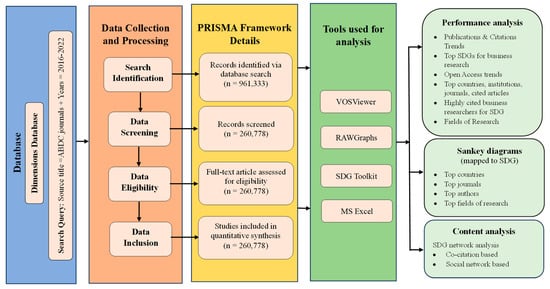
Figure 1.
Research Design and Methodology.
The Dimensions database has been used to examine business research publications on SDGs. The Dimensions database has the most exhaustive journal coverage, with 82.2% more journals than Web of Science and 48.1% more journals than Scopus [41].
We have used the Australian Business Deans Council (ABDC 2022) [42] list as a proxy for business research. There are multiple journal rankings measuring academic journals in business research; among them, ABDC is extensively used globally [17]. A total of 2680 journals in the ABDC list covers fields like accounting, auditing, and accountability; banking, finance, and investment; business systems in context; commercial services; human resources and industrial relations; marketing; strategy, management, and organizational behavior; tourism; transportation, logistics and supply chains; commerce, management, tourism, and services; applied economics; econometrics; economic theory; information systems; commercial law; and statistics. The ABDC list is further classified into four categories as follows. A*: the highest quality category (7.4%); A: the second highest quality category (24.4%); B: the third highest quality category (31.9%); C: the fourth highest quality category (36.3%).
Research publications are being mapped to SDGs by numerous initiatives:
- The Aurora-Network-Global’s SDG-Queries (Github. n.d.) [43] initiative maps sustainable development research by providing comprehensive queries.
- Digital Science’s SDG mapping initiative provides a deeper understanding of sustainable development research as it explores the thematic landscape, collaboration patterns, and funding sources, helping stakeholders identify gaps and opportunities for SDG research.
- The University of Auckland’s SDG Mapping initiative (Auckland’s SDG mapping, n.d.) [44] visualizes the relationship between research outputs and SDGs. Through this interactive platform, users can explore the impact of research projects on specific SDGs, facilitating informed decision-making and fostering collaboration.
- The STRINGS initiative (Strings, n.d.) [45] aims to map and monitor the progress of sustainable development goals worldwide.
- Elsevier’s SDG Mapping Initiative (Elsevier’s, n.d.) [46], where publications are mapped to each of the 17 SDGs through 17 different SDG queries.
We chose the Digital Science SDG initiative because it is directly integrated with the Dimensions database and provides pre-set search queries for each SDG to facilitate the research process. Experts and academics undertook a thorough review and feedback process to refine the precision of these queries, which increasingly use a machine-learning model.
We employed the “Preferred Reporting Items for Systematic Reviews and Meta-Analyses” (PRISMA) to conduct scientific research. This methodology facilitated the search, categorization, and refinement of the obtained results, as depicted in Figure 1. The PRISMA protocol was chosen for its ability to enhance the reliability and reproducibility of reviews, owing to its comprehensive approach and widespread utilization in bibliometric studies [47]. Our search was conducted between 1 February and 4 February 2023.
A Sankey diagram is a flow diagram commonly used to visualize the movement of resources within a system. The diagram’s arrows, or “flows”, represent the magnitude of the flow, while the rectangles, or “nodes”, represent the significance of the system’s elements. The width of the arrows is proportional to the flow’s relative magnitude, while the height of the rectangles reflects the relative importance of the elements within the system. Bibliometrics studies, such as those by [48,49,50], have used Sankey diagrams to visualize the intellectual structure of various aspects of research, including journals, authors, and countries. To design the Sankey diagram for mapping the top countries, top journals, top authors, and fields of research with SDG, “Rawgraphs” (Rawgraphs, n.d.) [51] has been used. Rawgraphs is an open-source data visualization framework built to simplify the visual representation of complex data for everyone [52]. Subsequently, “VOSviewer”, version 1.6.15, has been used for cluster analysis. VOSviewer is a software application for constructing and visualizing bibliometric networks [53]. For data filtering, sorting, listing, and graphs, “MS Excel” has also been used.
In our study, social network analysis (SNA) using centrality measures like betweenness and eigenvector has been used. SNA provides a deeper understanding of the SDGs’ interconnected nature, which is vital for holistic and effective SDG initiatives. These measures help highlight key SDGs within the network, providing insights to enhance strategic planning. Betweenness centrality identifies SDGs that serve as significant connectors or bridges, demonstrating their potential to influence numerous other goals. If targeted effectively, these SDGs can cause extensive positive impacts across the network. On the other hand, eigenvector centrality pinpoints influential SDGs that are not just well-connected but linked to other highly connected goals. Addressing these SDGs could result in systemic improvements, simultaneously progressing toward multiple SDGs. For analyzing the network of SDG goals, “SDGToolkit” (SDGToolkit, n.d.) [54] has been used for constructing an SDG network based on eigenvector and betweenness [55].
4. Performance Analysis–Results and Discussion
Evaluating and reporting a journal’s publications, citations, and impact involves conducting a comprehensive performance analysis [56]. This analysis goes beyond the typical participant profile observed in empirical research, providing a more in-depth and evaluative perspective. The performance analysis encompasses various metrics including publications, citations, top-ranked journals, countries, institutions, etc.
4.1. Publications and Citations Trends
Our first research question examines the publications and citation trends. We found that 961,333 publications (TP) related to business research have been published when filtered based on ABDC journals. However, only 260,778 publications (TPS, 27%) were mapped to UN SDGs. From Figure 2, we can see that research productivity in business research, as measured by the number of publications (TP), has increased from 34% from 2016 to 2022, while the number of publications mapped to SDGs (TPS) in the same period has increased by 68%. The percentage of total publications (TPS) mapped to SDGs has consistently increased from 23% in 2016 to 29% in 2022.
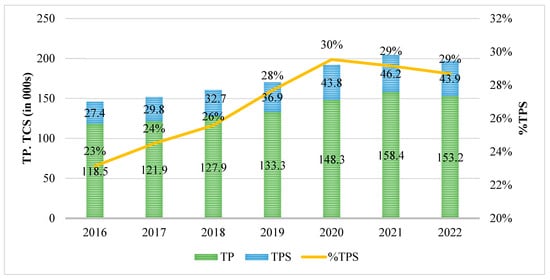
Figure 2.
Publications trends. Note: TP—total publications; TPS—total publications mapped to SDGs.
As seen in Figure 3, regarding research influence, as measured by citations (TC), there has been a 3617% increase from 2016 to 2022 and a 4556% increase in citations from SDG-mapped publications (TCS) in the same period. Similarly, the percentage of total citations from publications mapped to SDGs (TCS) has shown a healthy upward trend, increasing from 28% in 2016 to 36% in 2022.
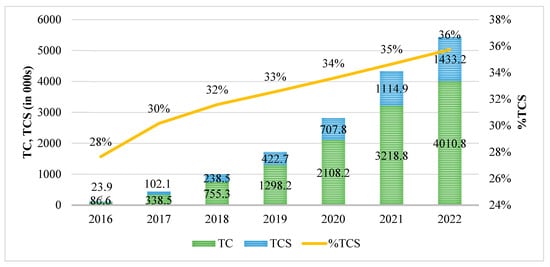
Figure 3.
Citations trends. Note: TC—total citations; TCS—total citations from publications mapped to SDGs.
4.2. Top SDGs for Business Research
According to the research productivity (TPS) and research influence data (TCS) shown in Figure 4, the SDGs with the highest productivity and the highest influence are SDG 3 (Good Health and Well Being) and SDG 7 (Affordable and Clean Energy). The SDGs with high productivity but low influence include SDG 16 (Peace, Justice, and Strong Institutions) and SDG 8 (Decent Work and Economic Growth). The SDGs with low productivity but high influence include SDG 13 (Climate Action) and SDG 12 (Responsible Consumption and Production). The SDGs with low productivity and low influence include SDG 11 (Sustainable Cities and Communities), SDG 9 (Industry, Innovation, and Infrastructure), SDG 15 (Life on Land), SDG 12 (Responsible Consumption and Production), SDG 10 (Reduced Inequalities), SDG 5 (Gender Equality), SDG 2 (Zero hunger), and SDG 1 (No Poverty).
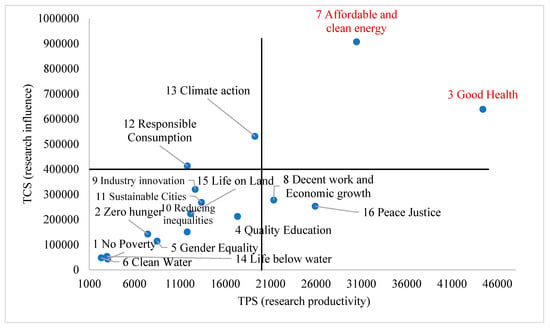
Figure 4.
Top SDGs based on research productivity (TPS) and research influence (TCS). Note: TPS—Total publications mapped to SDG; TCS—Total citations from publications mapped to SDG.
4.3. Open Access (OA) Trends
Our third research question is about finding trends in open-access publications and citations (Figure 5). Ref. [57] states that the Internet has allowed more individuals to access free, open-access (OA) publications. The percentage of publications mapped to SDGs and available under open access has increased from 26% in 2016 to 35% in 2022. During this same period, the number of citations for these publications increased from 23% to 31%. This compares to the general growth in OA, about 21% annually [58].
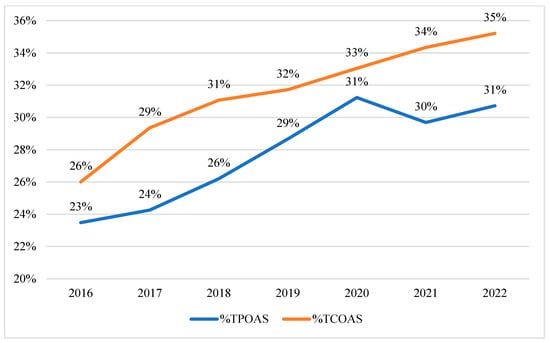
Figure 5.
Trends of SDGs mapped open access publications. Note: TPOAS—Total publications in open access mapped to SDG; TCOAS—Total citations from publications in open access mapped to SDGs.
From the data in Figure 6, Good Health and Well Being (SDG 3) has the highest number of SDG-mapped open access publications. The second highest is for Affordable and Clean Energy (SDG 7). The number of publications decreases for the remaining SDGs, with the lowest number being for Partnership for Goals (SDG 17).
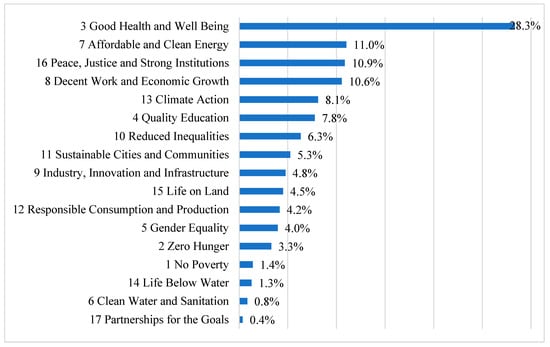
Figure 6.
Distribution of SDG mapped open access publications.
4.4. Top Ranked Countries
Table 1 lists the TPS and TCS values for countries focused on SDG research, ranked by TPS. The United States has the highest TPS and TCS values, indicating the highest research productivity and impact among the listed countries. China has the second highest TPS and TCS values, followed by the United Kingdom in third place. The TPS and TCS values generally decrease as we move down the list, with Australia, Germany, Canada, Italy, India, Spain, Netherlands, and France having progressively lower values.

Table 1.
Top ranked countries according to TPS and their SDG Rank.
The United States, China, United Kingdom, Australia, and Germany have the most publications mapped to the Sustainable Development Goals (SDGs) according to the Sankey diagram in Figure 7. Among these countries, SDG 3 (Good Health and Well Being), SDG 7 (Affordable and Clean Energy), SDG 13 (Climate Action), SDG 16 (Peace, Justice, and Strong Institutions), and SDG 8 (Decent Work and Economic Growth) are the most commonly mapped. On the other hand, SDG 9 (Industry, Innovation and Infrastructure), SDG 12 (Responsible Consumption and Production), and SDG 15 (Life on Land) are the least commonly mapped.

Figure 7.
Top ranked countries and their SDG mappings.
4.5. Highly Productive Institutions
The research productivity (TPS) and impact (TCS) of highly productive institutions contributing to SDG research are shown in Figure 8. Harvard University (United States), Tsinghua University (China), Hong Kong Polytechnic University (China), and the University of Oxford (United Kingdom) have the highest TPS and TCS values among the listed institutions. University College London (United Kingdom) and the University of Melbourne (Australia) have high research productivity, but their publications have fewer citations when compared with Harvard University and Tsinghua University. NUS (Singapore), Cambridge (United Kingdom), and Stanford (United States) have high research impact and lower research productivity. Australia is the leading country with five top institutions, followed by the United States and the United Kingdom with four institutions each.
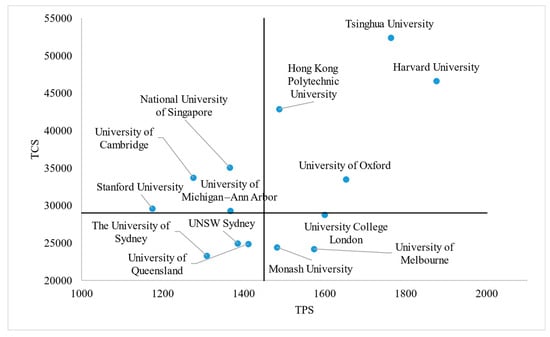
Figure 8.
Highly productive institutions contributing to SDG research. Note: TPS—Total publications mapped to SDG; TCS—Total citations from publications mapped to SDG.
Figure 9 shows the leading universities whose publications are mapped to SDGs. Harvard University has SDG 3 as the top researched SDG. Tsinghua University and Hong Kong Polytechnic University have SDG 7 as the most researched SDG. Among the high potential institutions that are highly cited but less productive, the National University of Singapore is found to be more productive in SDG 7. In contrast, SDG 3 is the prime research focus for the University of Michigan-Ann Arbor and the University of Cambridge. Stanford University is missing. These institutions can be on the list of highly productive and impactful institutions if they keep working like this by increasing their productivity rate without compromising their keen emphasis on impact. Among the highly productive but less impactful institutions, the University of Melbourne, University College London, and Monash University all keep SDG 3 as their highest SDG focus. Three Australian institutions, namely UNSW Sydney, The University of Sydney, Queensland University, etc., are heading towards the highly productive but less impactful category from their current status of less productive and less impactful institutions. Interestingly, all these institutions also have SDG 3 as their prime focus.
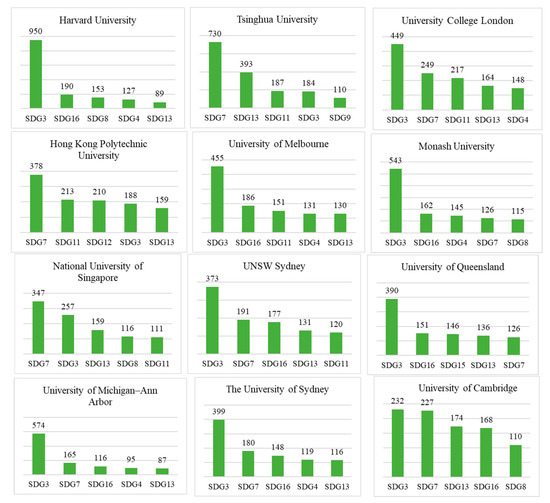
Figure 9.
Highly productive institutions and their top five SDG focus.
Thus, for all the categories taken together, SDG 3 is the most researched SDG, followed by SDG 7. SDG 13, SDG 11, and SDG 16 are also found in many institutions’ top SDG focus positions (when all four categories are taken together). Those who want to research these SDGs can either aim to join these institutions or collaborate with these top institutions. National and international policymaking bodies can approach these institutions to get help with suitable inputs for policy formulations, form action committees, and get resource personnel for training suitable personnel or workforces for implementation purposes.
4.6. Most Cited Journals
Figure 10 shows that the Journal of Cleaner Production has the highest TPS and TCS values, indicating the highest research productivity and impact among the listed journals. Applied Energy has the second highest TPS and TCS values, followed by the European Journal of Public Health in third place but at a much lower TCS value. The remaining journals have progressively lower TPS and TCS values, with Marine Policy and Accident Analysis and Prevention having the lowest values.
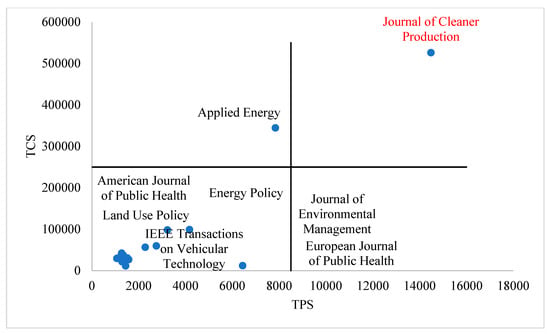
Figure 10.
Most cited journals contributing to SDG research. Note: TPS—Total publications mapped to SDGs; TCS—Total citations from publications mapped to SDGs.
The Sankey diagram in Figure 11 shows that The Journal of Cleaner Production, Applied Energy, and the European Journal of Public Health are the top journals according to research productivity. These journals have the most publications mapped to multiple SDGs. The most commonly mapped SDGs for these top journals are SDG 7 (Affordable and Clean Energy), SDG 13 (Climate Action), and SDG 3 (Good Health and Well Being). On the other hand, the least commonly mapped SDGs for these journals are SDG 8 (Decent Work and Economic Growth), SDG 5 (Gender Equality), and SDG 1 (No Poverty). These patterns suggest that the top journals in the table tend to focus more on energy, climate, and health issues while publishing fewer publications on issues related to economic growth, gender equality, and poverty.
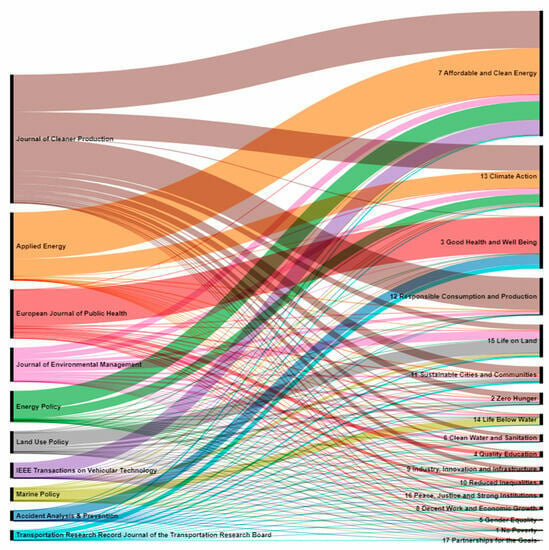
Figure 11.
Most cited journals and their SDG mappings.
When it comes to the analysis of the SDG focus of journals, Figure 12 shows that the Journal of Cleaner Production (which published the highest number of publications and obtained the highest number of citations) is found to publish more works in SDG 7, followed by SDGs 12, 13, 11 and 2. The Journal of Applied Energy, which is highly cited but has not published many publications and can be expected to drift towards the quadrant of the Journal of Cleaner Production, also focused more on SDG 7, followed by SDGs 13, 11, 12, and 15. The rest of the journals are in the low number of publications–low citations category. While Energy Policy and IEEE Transactions on Vehicular Technology are found to focus more on SDG 7, the journals European Journal of Public Health and Accident Analysis and Prevention focus mostly on SDG 3. The journals Journal of Environmental Management and Land Use Policy are found to have SDG 15 as the prime focus. Marine Policy published more publications on SDG 14, followed by SDGs 15, 13, 16, and 7.
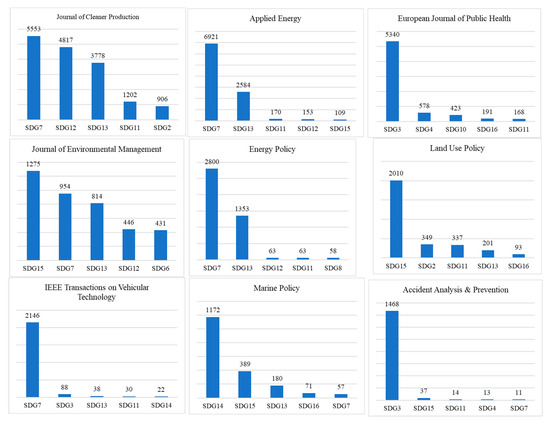
Figure 12.
Most cited journals with their top five SDG mappings.
In all the top journals, SDGs 7, 13, and 11 are the highest listed SDGs (appear in 7 of the 9 journals). SDG 15 is listed in 5 of the top journals, and SDG 12 is found to be listed in 4 of the top journals. So, considering the journals associated with business research, SDGs 7, 13, and 11 are the most emphasized SDGs. The most targeted SDGs after these are SDGs 15 and 12. Thus, business research researchers interested in SDGs can choose these SDGs to conduct their research and target these top journals. National and international policymakers related to business research and SDGs should at least follow publications in these top journals to stay informed about the important developments and trends in business research and its various aspects related to SDGs.
4.7. Top Cited Publications
The top cited publications presented in Table 2 are a review of publications related to the circular economy. It conducted an extensive literature review using bibliometric analysis and snowballing techniques to investigate state-of-the-art sustainability to determine the similarities, differences, and relationships between the circular economy and sustainability. It found that the circular economy is mostly an essential condition, a beneficial relation or trade-off for sustainability. The second work in Table 2 is a review of the circular economy intended to grasp the main CE features and perspectives such as origins, basic principles, advantages and disadvantages, modeling, and implementation of CE at the different levels (micro, meso, and macro) worldwide. Its roots were traced to ecological and environmental economics and industrial ecology. Its goal is to decouple environmental pressure from economic growth, and a major focus was identified on recycling than reusing. Waste management is an activity sector that produced important results, and the interdisciplinary framework underpinning CE is expected to offer good prospects for gradual improvement of the present (inadequate) production and consumption models. Both these works were mapped to SDG 12. The third paper in Table 2 presented the overview of the shared economic pathways (SSPs) (a part of the new scenario framework established by the climate change research community) and implications on their energy, land use, and emissions. That work facilitated the integrated analysis of future climate impacts, vulnerabilities, adaptation, and mitigation and allowed subsequent use and development in new assessments and research projects. This work is mapped to SDG 13.

Table 2.
Top-cited publications and their SDG focus.
The fourth work in the table presented Nextstrain, consisting of a viral genome database, a bioinformatics pipeline for phylodynamic analysis, and an interactive visualization platform. It is a compilation of current understanding in a single accessible location, open to health professionals, epidemiologists, virologists, and the public alike. This work falls in SDG 3. The fifth work in the top cited list conducted a comprehensive review of Industry 4.0 and presented an overview of the content, scope, and findings of Industry 4.0 by examining the existing literature in Web of Science. That paper discussed the critical issue of the interoperability of Industry 4.0 and introduced a conceptual framework of interoperability regarding Industry 4.0, along with a discussion of challenges and trends for future research on Industry 4.0. The sixth work is also about the circular economy, wherein a critical concept analysis from the environmental sustainability perspective was conducted. It identified six challenges related to thermodynamics and system boundaries that need to be solved to secure the actual environmental impacts of CE.
The seventh work is about Industry 4.0. It discussed various contributing technologies vital for Industry 4.0 and originates from disciplines like cyber-physical systems, IoT, cloud computing, industrial integration, enterprise architecture, SOA, business process management, and industrial information integration. It observed that the lack of powerful tools is a major obstacle to exploiting the full potential of Industry 4.0. The eighth work is a comprehensive review of the circular economy in the context of the manufacturing industry to discuss different aspects of resource scarcity, waste generation, and economic advantages. It also sought to explore the circular economy landscape when these three aspects are considered simultaneously and propose a concurrent implementation strategy using a top-down and bottom-up approach. It also observes that support from all stakeholders is vital for the successful implementation of the circular economy. The ninth paper in the list critically examines Blockchain technology and its relationship to supply chain management. It specifically examined how blockchains can overcome many potential barriers; four major barriers crucial for true blockchain-led business and supply chain transformations are identified as interorganizational, intraorganizational, technical, and external barriers. Methodsw for overcoming barriers and adopting blockchain technology for supply chain management were also discussed. The tenth work in the list presented a narrative description of future societal development associated with the shared socioeconomic pathways in which plausible future changes in demographics, human development, economy, institutions, technology, and environment were described. Narratives were related to sustainability, regional rivalry, inequality, fossil fuel development, and a middle-of-the-road pathway.
From this analysis, major themes in the top 10 list are related to Industry 4.0, the circular economy, and shared socioeconomic pathways. The first two themes are mostly mapped to SDGs 12 and 9, while the third is mapped to SDG 13. A work on bioinformatics that deal with real-time tracking of pathogen evolution (mapped to SDG 3) and blockchain technology and its importance in supply chain management is also found in the top list. Thus, researchers craving business research in sustainable development goals can focus on these themes. Any business firm that cares about sustainability should also focus on following the trends in these themes to remain relevant and current. National policymakers should track the development of these themes to nurture a sustainable ecosystem within their country by ensuring that business research and developments in the country align with the global trends in sustainable development.
4.8. Top Authors
Table 3 shows the top authors who published articles in the business research domain and mapped with SDGs. The top three researchers in terms of research productivity and impact are Bo-Qiang Lin (China), Simplice Anutechia Asongu (Cameroon), and Muhammad Qaiser Shahbaz (China). These researchers have the highest TPS and TCS values among the listed individuals, indicating that they have the highest research productivity and impact. Bo-Qiang Lin works at Xiamen University in China, Simplice Anutechia Asongu works at the African Governance and Development Institute in Cameroon, and Muhammad Qaiser Shahbaz works at the Beijing Institute of Technology in China. Among these researchers, Muhammad Qaiser Shahbaz has the highest citation impact, at 87.66. Kannan Govindan, from Denmark, has the second highest citation impact, with a value of 78.85. They are particularly influential researchers in their field, with their work being highly cited by other researchers. The remaining researchers in the top ten have progressively lower citation impacts.

Table 3.
Top authors.
The Sankey diagram in Figure 13 shows that the top authors have published work that focuses the most on SDG 7 (Affordable and Clean Energy), SDG 13 (Climate Action), and SDG 12 (Responsible Consumption and Production). These are the most researched SDGs among the top authors. On the other hand, the least researched SDGs among the top authors are SDG 16 (Peace, Justice, and Strong Institutions), SDG 15 (Life on Land), and SDG 4 (Quality Education). Shunsuke Managi’s publications are mapped to the most SDGs, totaling 16. Ma-Lin Song’s publications are mapped to the second-highest number of SDGs, totaling 14.
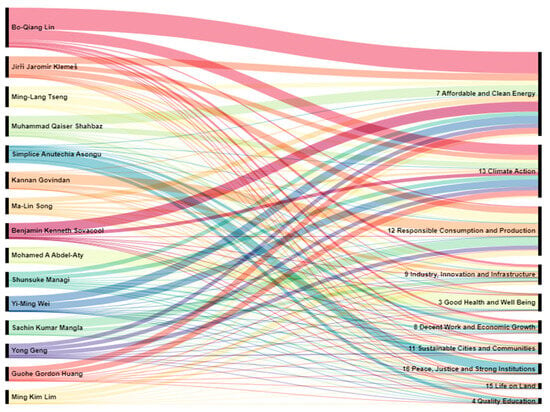
Figure 13.
Top authors with their SDG focus.
4.9. Fields of Research (FoR) and Their SDG Mappings
The Dimensions database uses The Australian and New Zealand Standard Classification of Occupations (ANZSCO) [69] to classify research fields. It provides a standardized framework for categorizing research fields and facilitates communication across different fields and disciplines. According to Table 4, FoR, applied economics has the greatest number of publications mapped to the SDGs, followed by strategy, management, and organizational behavior, and transportation, logistics, and supply chains. Regarding the research influence as measured by citations per article (TCS/TPS), building, information systems, and business systems in context are the leading fields of research.

Table 4.
Highly cited FoR with citations >100,000.
Next, we analyze the mapping of various FoR to SDGs using the Sankey diagram. According to Figure 14, SDG 3, which aims to ensure healthy lives and promote well-being for all, has the most publications mapped to it from the top fields of research. SDG 8, which aims to promote sustained, inclusive, and sustainable economic growth, full and productive employment, and decent work for all, and SDG 16, which aims to promote peaceful and inclusive societies for sustainable development, provide access to justice for all, and build effective, accountable, and inclusive institutions at all levels, also have a high number of publications mapped to them.
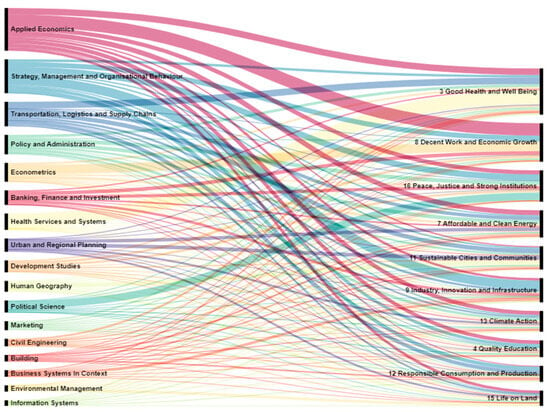
Figure 14.
Fields of research aligned with SDGs.
On the other hand, SDG 12, which aims to ensure sustainable consumption and production patterns, and SDG 15, which aims to protect, restore, and promote the sustainable use of terrestrial ecosystems, forests, oceans, and seas, have fewer publications mapped to them.
In our analysis of the SDG network, we employed two social network analysis (SNA) measures, namely betweenness and eigenvector centrality. SNA has been effectively employed in bibliometric studies to analyze the thematic structure of topics. For example, Ref. [70] utilized SNA for Twitter data, while Emrouznejad and Marra (2017) applied it to research on the analytic hierarchy process. For the first time, SNA was used in the context of SDG. Betweenness centrality is used to determine the importance of an SDG node as a connecting point for information flow in the network. This metric counts the number of times a node lies on the shortest path between two other SDG nodes. SDG nodes with high betweenness centrality are critical bridges connecting different network sections.
On the other hand, eigenvector centrality measures a node’s influence within the network, considering the centrality of the nodes it is connected to. According to [71], this metric considers the number of connections a node has and the centrality of the nodes it is connected to, implying that the significance of a node is determined by the number of important nodes it is connected to. In SDG networks, SDG nodes with high eigenvector centrality are considered central points of attention.
According to [72], the Sustainable Development Goals (SDGs) are interconnected, and the achievement of one goal is dependent on the success of the others. Using network analysis techniques, Ref. [55] demonstrated the uneven distribution of connections between SDGs. Some goals are linked to multiple targets, making them well connected to many other goals. In contrast, other goals have weak connections to the broader SDG system.
To illustrate the connections between the various SDGs, we utilized co-citation mapping in our study. This approach visualizes the proximity of SDGs on the map based on their co-citation occurrence, indicating that publications related to those SDGs are often cited together in the same publications. The nodes’ size reflects the SDGs’ frequency in overall publications, while the thickness of the edges represents how often these SDGs are co-cited. In our study, we utilized the SDG co-citation map and social network analysis to examine the top three fields of research further ranked based on the number of published publications.
4.9.1. Applied Economics
Applied economics is the most prolific FoR, with over 39,773 publications and 478,689 citations. Figure 15 shows SDG mappings for publications under the applied economics FoR. SDG 8 Decent Work and Economic Growth has received the most research attention, with 10,145 publications. Applied economics uses economic theory and quantitative methods to address real-world problems related to employment, poverty, and economic growth, which are all key concerns of SDG 8. The SDGs related to 3 Good Health and Well Being, 10 Reduced Inequalities, 7 Affordable and Clean Energy, 16 Peace, Justice, and Strong Institutions, and 13 Climate Action have been moderately researched. On the other hand, the SDGs focused on 6 Clean Water and Sanitation, 14 Life Below Water, and 17 Partnerships for the Goals have received the least research attention.

Figure 15.
Top SDGs in FoR applied economics.
As presented in Figure 16, the SDG network map produced three clusters. These clusters illustrate the interrelatedness of certain SDGs in terms of co-citation occurrence. The analysis of the SDG research publications has shown the existence of three distinct clusters.
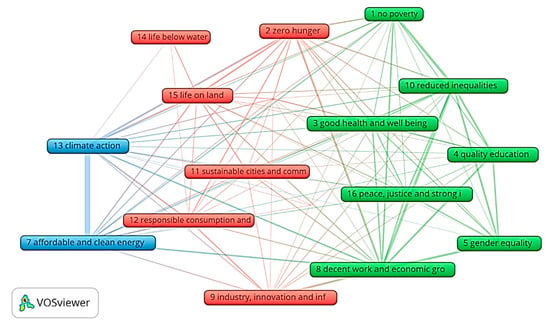
Figure 16.
SDG network map for applied economics.
- The first cluster (red) comprises 8964 publications, and its thematic focus is mainly on environmental sustainability. SDG 9 (industry, innovation, and infrastructure) is at the center of this cluster, and other interconnected SDGs include SDG 2 (zero hunger), SDG 15 (life on land), SDG 11 (sustainable cities and communities), SDG 12 (responsible consumption and production), SDG 6 (clean water and sanitation), and SDG 14 (life below water).
- The second cluster (green) has the largest number of publications (28,891) and citations (306,989). It covers a diverse range of topics, including SDG 8 (decent work and economic growth), SDG 3 (good health and well-being), SDG 10 (reduced inequalities), SDG 16 (peace, justice, and strong institutions), SDG 4 (quality education), SDG 5 (gender equality), and SDG 1 (no poverty). This cluster reflects the interconnectedness and interdependence of different aspects of economic development.
- The third cluster (blue) has 7350 publications and 142,152 citations and is focused on the topics of SDG 7 (affordable and clean energy) and SDG 13 (climate action). The cluster highlights the importance of energy and climate in sustainable development.
Unsurprisingly, SDG 8, which focuses on economic growth and employment, is most mapped in applied economics. Economic analysis can be used to identify the most effective policies and interventions for promoting economic growth and reducing unemployment and assess the social and environmental impacts of economic activities. SDG 3 (good health and well-being) is also closely related to applied economics, as economic analysis can be used to understand the costs and benefits of different health interventions and to design effective health policies. Similarly, SDG 7 (affordable and clean energy) is also closely linked as economic analysis can be used to understand the trade-offs and synergies between economic growth and environmental sustainability and the economic costs and benefits of transitioning to a low-carbon economy. Also seen are strong linkages between SDG 7 and SDG 13 and between SDG 8 and SDG 10 (reduced inequalities).
Figure 17a depicts the SDG network based on eigenvector centrality, which identifies SDG 8 (work, 0.106) as the most influential node with the highest eigenvector centrality value. SDG 13 (climate, 0.101) and SDG 12 (consumption, 0.101) are the network’s second and third most influential SDGs.
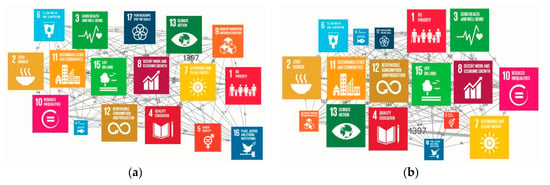
Figure 17.
(a) SDG network based on eigenvector, (b) SDG network based on betweenness.
Figure 17b displays an SDG network based on betweenness centrality, where the thickness of the links between SDGs represents the strength of the connection between them. The network reveals that the strongest connection is between energy and climate (SDG 7, 13), between work and inequalities (SDG 8, 10), and between gender and work (SDG 5, 8). Additionally, the figure highlights the central position of SDG 8 (work, 0.034), SDG 11 (cities, 0.034), SDG 12 (consumption, 0.034), and SDG 15 (land, 0.034) in the network.
According to Table 5, the Energy Economics journal has the highest TPS and TCS. It is most mapped to SDG 7, SDG 13, and SDG 8. The journal Ecological Economics has the second highest TPS and TCS and is most mapped to SDG 15, SDG 3, and SDG 7.

Table 5.
Top journals with SDG mapping.
Table 6 lists highly cited publications and their SDG mapping for the applied economics FoR. The highly cited article by [64] aims to contribute to the scientific research on the circular economy (CE) by defining the concept from the perspective of sustainable development and sustainability science and conducting a critical analysis of the concept from the environmental sustainability perspective. The analysis identifies six challenges related to thermodynamics and system boundaries that CE needs to address to contribute to net global sustainability and achieve SDG 12.

Table 6.
Highly cited publications and their SDG mappings.
Using panel study data from 1980 to 2010, Ref. [73] research found that the gender wage gap declined significantly during this time but remained higher at the top of the wage distribution. Conventional human capital factors explained little of the gap by 2010, while occupation and industry differences remained important. Noncognitive skills also play a small to moderate role in contributing to the gap. This research has implications for achieving SDG 5, which aims to achieve gender equality and empower all women and girls. The sharing economy, which includes activities such as peer-to-peer rental and service provision, has been discussed by [75] regarding its potential for sustainability and as a disruptive force in established economic structures. If the sharing economy becomes co-opted by corporations, it may not contribute to a transition to sustainability, which is a key goal of SDG 12.
4.9.2. Strategy, Management and Organizational Behavior
Strategy, management and organizational behavior is the second prolific FoR with over 28,977 publications and 448,074 citations. Figure 18 shows SDG mappings for publications under this FoR. SDGs 9 and 16 have the highest number of mapped publications. Effective strategy and management practices are critical to achieving both goals. For example, organizations must be managed effectively and have a clear strategy to drive innovation and sustainable industrialization. Organizational behavior, such as employee motivation and collaboration, is also important in promoting innovation and creativity. SDGs 8, 12, and 4 have a moderate number of mapped publications, while SDGs 15, 6, and 14 have the lowest number.
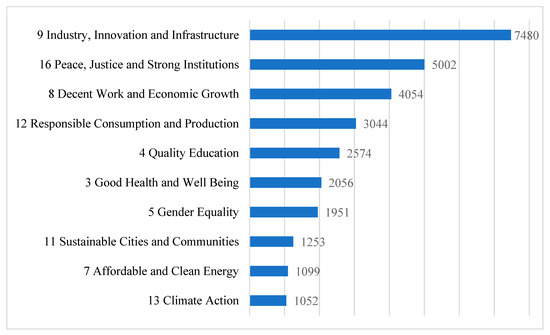
Figure 18.
Top SDGs in the FoR strategy, management and organizational behavior.
For this FoR, four clusters were identified based on mapping publications to SDGs (Figure 19).
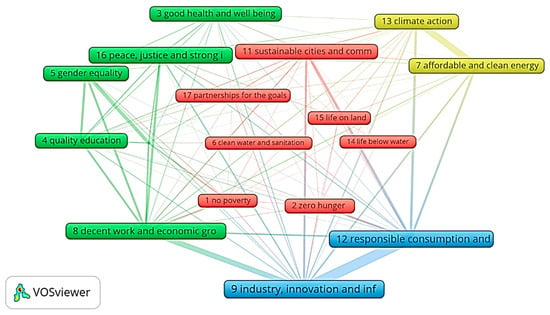
Figure 19.
SDG network map for Strategy, Management and Organizational Behavior.
- Cluster 1 (red) has 2503 publications with 36,685 citations to them. Several SDGs within this cluster are relevant to strategy, management and organizational behavior. For instance, SDG 11, Sustainable Cities and Communities, can be connected to strategic planning and management of resources to create sustainable and livable urban environments. Similarly, SDG 17 Partnerships for the Goals might be related to developing strategic partnerships and collaborations, which are crucial in achieving organizational objectives and fostering positive social impacts. Additionally, SDGs like 1 No Poverty and 2 Zero Hunger can influence organizational strategies aimed at socioeconomic inclusivity and sustainability, shaping management practices and organizational behavior towards more socially responsible actions.
- Cluster 2 (green) has the most publications, with 16,389 and 204,120 citations. Several SDGs from this cluster significantly affect the strategy, management, and organizational behavior research area. For example, SDG 8, Decent Work and Economic Growth, is closely tied to strategies encouraging economic growth, job creation, and fair labor practices within organizations. Similarly, SDG 4 Quality Education could relate to corporate training programs, employee development strategies, and commitment to fostering a knowledge-based organization. Furthermore, SDGs such as 5 Gender Equality and 10 Reduced Inequalities emphasize the importance of diversity and inclusivity in organizational strategies and policies, shaping management practices and organizational behavior towards more equitable workplaces.
- Cluster 3 (blue) has 10,554 publications and the most citations, with 227,740. The SDGs included in this cluster are 9 industry, innovation, and infrastructure, and 12 responsible consumption and production. For example, SDG 9 Industry, Innovation, and Infrastructure are related to strategic planning for business growth, where companies need to continuously innovate, upgrade their infrastructure, and invest in industrial processes to stay competitive. Simultaneously, SDG 12, Responsible Consumption and Production, could inform the development of strategies for sustainable supply chain management and production methods, encouraging organizations to consider the environmental impact of their operations and promoting responsible consumption behaviors among stakeholders.
- Cluster 4 (yellow) has 2155 publications with 33,692 citations of them. The SDGs included in this cluster are SDG 7 Affordable and Clean Energy and SDG 13 Climate Action. SDG 7 could influence strategic decisions and management practices around energy use and sourcing in organizations, focusing on transitioning to more sustainable and affordable energy options. Furthermore, SDG 13 highlights businesses’ need to incorporate climate change mitigation and adaptation strategies into their operational and strategic planning.
In Figure 20a, the SDG network based on the eigenvector network identifies SDG 9 (industry, 0.070) as the most influential node, with the highest eigenvector centrality value. SDG 11 (cities, 0.065) and SDG 13 (climate, 0.061) are the network’s second and third most influential SDGs.

Figure 20.
(a) SDG network based on eigenvector, (b) SDG network based on betweenness.
On the other hand, Figure 20b displays an SDG network based on betweenness centrality. This analysis reveals the central position of SDG 9 (industry, 0.037) and SDG 11 (cities, 0.024) in the network. The results of both eigenvector and betweenness centrality analyses suggest that SDG 9 (industry) and SDG 11 (cities) are key SDGs highly influential and centrally positioned in the network. The network reveals that the strongest connection is between industry and consumption (SDG 9, 12), between energy and climate (SDG 7, 13), and between work and industry (SDG 8, 9).
Table 7 lists the top journals with their SDG mappings. Business Strategy and the Environment journal has the highest count of 577 publications, which have been cited 15,859 times, and focus on SDGs 12, 9, and 13. The Journal of Business Research has published 485 publications, which have been cited 15,218 times and focus on SDGs 9, 16, and 8. Finally, the journal Technological Forecasting and Social Change has published 374 publications with the highest citation count of 16,327, and they address SDGs 9, 12, and 7.

Table 7.
Top journals with SDG mapping.
Table 8 lists the highly cited publications in this field of research with their key focus and SDG mappings.

Table 8.
Highly cited publications with SDG mapping.
A highly cited study by [76] found that the theory of planned behavior (TPB) mediates the relationship between environmental concern and green product purchase intention, making it a useful tool for understanding consumer behavior in the context of SDG 12, which aims to ensure responsible consumption and production.
Artificial Intelligence (AI) is transforming the service industry by performing various tasks, leading to innovation and posing a threat to human jobs. A theory of AI job replacement has been developed to address this dual impact [77]. The theory suggests that AI job replacement occurs at the task level rather than the job level and will first replace tasks requiring lower levels of intelligence. This study maps to SDG 8, which aims to promote sustained, inclusive, and sustainable economic growth, full and productive employment, and decent work.
Ref. [78] identified contextual conditions in the Brazilian industry that may require partially implementing Industry 4.0 concepts developed in developed countries. It analyzed how adopting various Industry 4.0 technologies is associated with expected benefits for products, operations, and side effects. The results of this study are aligned with SDG 9, which aims to build resilient infrastructure, promote inclusive and sustainable industrialization, and foster innovation.
Effective strategic planning and management are essential for implementing development projects sustainably and inclusively, as highlighted by SDG 9 (resilient infrastructure, inclusive and sustainable industrialization, and innovation). Good management practices, such as transparency and accountability, can also help to build trust and confidence in institutions and promote peaceful and inclusive societies, as highlighted by SDG 16 (peace, justice, and strong institutions). In addition, organizational behavior can be used to understand and address conflicts and challenges within organizations, promote workers’ well-being, and improve productivity, which is relevant for achieving SDG 8 (sustained, inclusive, and sustainable economic growth and employment).
4.9.3. Transportation, Logistics and Supply Chains
The field of research transportation, logistics, and supply chains, which boasts 18,480 publications and 35,887 citations, exhibits a diverse spread of interests concerning the Sustainable Development Goals (SDGs) (Figure 21). Most prominently, SDG 3 (Good Health and Well-being) dominates this field with 5523 publications, indicating a significant focus on health-related logistics and supply chain management. Furthermore, SDGs 11 (Sustainable Cities and Communities), 12 (Responsible Consumption and Production), and 7 (Affordable and Clean Energy) have also received considerable attention, reflecting a concern for sustainable urban logistics and the responsible management of resources in this field. SDGs 9 (Industry, Innovation, and Infrastructure), 15 (Life on Land), and 13 (Climate Action) occupy a moderate amount of research space, highlighting the field’s recognition of the role of innovative infrastructure and environmental sustainability in transport and supply chain solutions. In contrast, SDGs 2 (Zero hunger), 8 (Decent Work and Economic Growth), and 10 (Reduced Inequalities) have been less addressed, suggesting potential areas for further research to explore how logistics and supply chain management can contribute to reducing hunger, promoting decent work, and reducing inequalities.
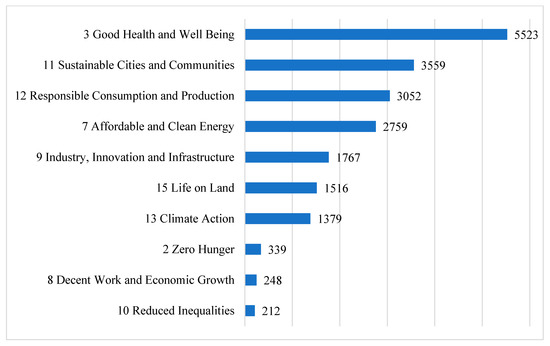
Figure 21.
Top SDGs in transportation, logistics and supply chains.
The SDG network map in Figure 22 produced three clusters.
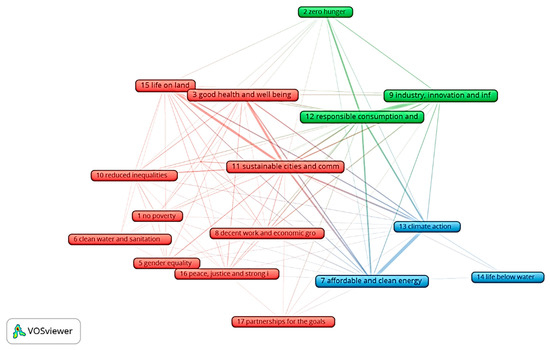
Figure 22.
SDG network map for transportation, logistics and supply chains.
- Cluster 1 (red) is the biggest, with 11,613 publications and 180,736 citations. This cluster includes SDGs 3 Good Health and Well-being, 11 Sustainable Cities and Communities, 15 Life on Land, 8 Decent Work and Economic Growth, 10 Reduced Inequalities, 4 Quality Education, 16 Peace, Justice and Strong Institutions, 5 Gender Equality, 6 Clean Water and Sanitation, and 17 Partnerships for the Goals. SDG 8 can be related to creating jobs and promoting economic growth by expanding and improving transportation and logistics infrastructure. Meanwhile, SDG 11 might involve the development of sustainable and efficient transportation systems that reduce environmental impact and improve quality of life in urban settings.
- Cluster 2 (green) has 5157 publications and 147,065 citations, focusing on SDGs 12 Responsible Consumption and Production, 9 Industry, Innovation, and Infrastructure, and 2 Zero Hunger. SDG 12 may relate to the sustainable management of supply chains to reduce waste and environmental impact. SDG 9 may involve sustainable transportation solutions to improve urban mobility and reduce traffic congestion.
- Cluster 3 (blue), which consists of 4179 publications and 93,367 citations, is centered around SDGs 7 Affordable and Clean Energy, 13 Climate Action, and 14 Life Below Water. SDG 7 can be associated with the shift towards more energy-efficient transportation systems, like electric vehicles or renewable energy-powered logistics solutions. SDG 13 aligns with the need for greener supply chains and transportation systems to reduce their carbon footprints and combat climate change.
In the largest cluster (red), strong linkages are seen between health and life on land (SDG 3 and 15), between sustainable cities and life on land (SDG 13 and 15), and between health and sustainable cities (SDG 3 and 11). In the green cluster, consumption and industry have strong linkages, while the blue cluster shows the interrelatedness between energy and climate (SDG 7 and 13).
Figure 23a illustrates that SDG 11 (cities, 0.079) is the most influential node in the eigenvector network, with the highest eigenvector centrality value. SDG 7 (energy, 0.072) and SDG 13 (climate, 0.071) follow as the network’s second and third most influential SDGs. Figure 23b, on the other hand, presents an SDG network based on betweenness centrality, which highlights the central position of SDG 7 (energy, 0.079) in the network. The network reveals the strongest connection between industry and consumption (SDG 9, 12) and energy and climate (SDG 7, 13). The results of both eigenvector and betweenness centrality analyses suggest that SDG 7 (energy) is highly influential and centrally positioned in the network.

Figure 23.
(a) SDG network based on eigenvector, (b) SDG network based on betweenness.
Table 9 shows the top journals and their SDG mappings. The Transportation Research Record Journal of the Transportation Research Board has published the highest number of 1522 publications, which have been cited 10,320 times and focus on SDGs 3, 11, and 15. Accident Analysis & Prevention has published 1322 publications with the highest citations, 26,130, focusing on SDGs 3, 15, and 11.

Table 9.
Top journals with SDG mapping.
Table 10 lists highly cited publications in this field of research. In the study [67], the authors examine the potential applications of blockchain technology and smart contracts for supply chain management, focusing on how they can help meet sustainability goals. The globalization of supply chains has made their management and control more complex, but blockchain technology can address some of these challenges to help achieve SDG 12 on responsible consumption and production.

Table 10.
Highly cited publications with SDG mapping.
The paper by [79] examines the potential effects of blockchain on key supply chain management objectives such as cost, quality, speed, dependability, risk reduction, sustainability, and flexibility. This study has implications for SDG 12 as blockchain technology’s increased transparency and accountability could contribute to more sustainable supply chain practices.
To review and classify the literature on the application of big data business analytics (BDBA) in logistics and supply chain management (SCM), this study by [80] defines SCM analytics as supply chain analytics (SCA) based on the nature of analytics (descriptive, predictive, prescriptive) and the focus of SCM (strategy and operations). The authors propose a maturity framework for SCA based on four capability levels: functional, process-based, collaborative, agile SCA, and sustainable SCA. This work has implications for SDG 12 as using big data and analytics in SCM can help optimize supply chain processes and make them more sustainable.
Transportation, logistics, and supply chains are closely related to several of the SDGs, including SDG 3 (good health and well-being), SDG 11 (sustainable cities and communities), and SDG 12 (responsible consumption and production). These systems support the movement of goods and materials, including medical supplies and other essential products, and can improve access to healthcare and other services. Efficient and sustainable transportation and logistics can also support the development of compact, connected, and sustainable cities and reduce the environmental impact of consumption and production. Future research could identify ways to optimize and decarbonize transportation and logistics networks, improve supply chain transparency and traceability, and develop sustainable and resilient supply chain management practices that align with multiple SDGs.
5. Conclusions
Our current research indicates a robust increase in business research productivity between 2016 and 2022, notably in research papers aligned with Sustainable Development Goals (SDGs). A remarkable surge is also seen in citations, a measure of research influence for the same period. A rising proportion of total publications and citations associated with SDGs suggests a greater emphasis on these global development goals within business research.
In response to the first research question regarding publication trends, our current research indicates a robust increase in business research productivity between 2016 and 2022, notably in research papers aligned with Sustainable Development Goals (SDGs). A remarkable surge is also seen in citations, a measure of research influence for the same period. A rising proportion of total publications and citations associated with SDGs suggests a greater emphasis on these global development goals within business research.
Our second research question focused on the SDGs that business researchers must explore. Our study shows that business research is most mapped to SDGs 3 (Good Health and Well Being) and 7 (Affordable and Clean Energy), which shows the highest productivity and influence, while SDGs 16 (Peace, Justice, and Strong Institutions) and 8 (Decent Work and Economic Growth) show high productivity but low influence. Conversely, SDGs 13 (Climate Action) and 12 (Responsible Consumption and Production) have low productivity yet high influence.
Our third research question enquired if open-access journals have better followers than others. Open access has been a growing trend, with a substantial rise in citations from such works, suggesting a response to our third research question. Of particular interest is the focus of open access publications on SDG 3 (Good Health and Well Being) and SDG 7 (Affordable and Clean Energy), with the fewest publications relating to SDG 1 (No Poverty). Assessing individual SDGs, SDG 3 (Good Health and Well Being) and SDG 7 (Affordable and Clean Energy) demonstrate the highest research productivity and influence.
Our fourth research question enquired about the top participating nations, institutions, and journals for SDG research. Findings suggested that the United States, China, and the United Kingdom outperform regarding research productivity and influence at the international level. The most represented SDGs among these top-performing nations include SDG 3 (Good Health and Well Being), SDG 7 (Affordable and Clean Energy), SDG 13 (Climate Action), SDG 16 (Peace, Justice, and Strong Institutions), and SDG 8 (Decent Work and Economic Growth). In contrast, SDG 9 (Industry, Innovation, and Infrastructure), SDG 12 (Responsible Consumption and Production), and SDG 15 (Life on Land) receive less attention.
In the academic realm, universities such as Harvard, Tsinghua, and Hong Kong Polytechnic University lead in terms of research productivity and influence related to SDG 3 (Good Health and Well Being) and SDG 7 (Affordable and Clean Energy). Other universities, such as University College London and the University of Melbourne, show high productivity in these areas but less influence as measured by citations. Of note is the significant representation of Australian institutions, particularly in research associated with SDG 13 (Climate Action) and SDG 12 (Responsible Consumption and Production). Most institutions prioritize SDG 3 (Good Health and Well Being) and SDG 7 (Affordable and Clean Energy) in their research.
Journal productivity and impact mirror these trends, with the Journal of Cleaner Production, Applied Energy, and the European Journal of Public Health at the forefront. These journals largely focus on SDG 7 (Affordable and Clean Energy), SDG 13 (Climate Action), and SDG 3 (Good Health and Well Being), with less emphasis on SDG 8 (Decent Work and Economic Growth), SDG 5 (Gender Equality), and SDG 1 (No Poverty). This suggests a primary focus on energy, climate, and health, while economic growth, gender equality, and poverty receive less attention.
Our fifth research question enquired about identifying the top authors and their focused SDG areas. Finally, top authors focus their research mainly on SDG 7 (Affordable and Clean Energy), SDG 13 (Climate Action), and SDG 12 (Responsible Consumption and Production), with few publications dedicated to SDG 1 (No Poverty), SDG 8 (Decent Work and Economic Growth), and SDG 5 (Gender Equality).
Our next and sixth research question attempted to identify the top academic disciplines contributing to SDGs. The presented research has analyzed the significant role of the top three fields of research (FoR), namely applied economics, strategy management and organizational behavior and transportation logistics and supply chains, in addressing the SDGs. Each FoR uniquely contributes to specific SDGs, thus contributing to our understanding of the relationship between research fields and the global sustainability agenda.
Applied economics has emerged as the dominant FoR contributing to the SDG discourse, especially towards SDG 8 (Decent Work and Economic Growth), suggesting its integral role in addressing employment, poverty, and economic growth concerns. The field also provides significant insights related to SDGs on Health (3), Reduced Inequalities (10), Affordable and Clean Energy (7), Peace, Justice, and Strong Institutions (16), and Climate Action (13). However, certain SDGs like Clean Water and Sanitation (6), Life Below Water (14), and Partnerships for the Goals (17) require more research focus. Strategy, management, and organizational behavior, the second most prolific FoR, makes substantial contributions towards SDGs 9 (Industry, Innovation, and Infrastructure) and 16 (Peace, Justice, and Strong Institutions), emphasizing the importance of strategic planning, management practices, and organizational behavior in driving innovation and sustainable industrialization. In transportation, logistics, and supply chain management, we see the most significant contribution to SDG 3 (Good Health and Well Being), emphasizing the sector’s pivotal role in healthcare logistics. Furthermore, it contributes substantially towards SDG 11 (Sustainable Cities and Communities) and SDG 12 (Responsible Consumption and Production), demonstrating its influence on urban planning and sustainable consumption patterns.
Our next and seventh research question aimed to identify the interconnection between the several SDGs. The research networks for the three FoRs, mapped through SNA, comprised clusters corresponding to common thematic areas. For applied economics, SDGs 9 (Industry, Innovation, and Infrastructure), 8 (Decent Work and Economic Growth), and 7 (Affordable and Clean Energy) were among the key influential nodes, revealing their centrality in the field. Likewise, in strategy, management, and organizational behavior, SDGs 9 (Industry, Innovation, and Infrastructure) and 11 (Sustainable Cities and Communities) emerged as the central nodes, signifying their influence and central positioning in the network. Additionally, SDG 9 displayed strong connectivity with SDG 12 (Responsible Consumption and Production), reflecting the relevance of effective management practices in driving innovation and sustainable industrialization. By examining the co-citation patterns of SDGs, we were also able to highlight the intertwined nature of various goals and the prevalence of certain clusters, such as the environment, development, and energy-climate nexus. We noted, for example, a strong linkage between SDG 7 (Affordable and Clean Energy) and SDG 13 (Climate Action), reinforcing the importance of energy and climate in sustainable development.
In sum, the research underscores the pivotal role of diverse research fields in addressing the complex, interconnected global sustainability challenges encapsulated in the SDGs. It emphasizes the necessity of multidisciplinary research collaboration and strategic focus on under-explored SDGs to foster a balanced advancement toward the global sustainability agenda.
5.1. Theoretical Implications
This study sheds light on how business research can advance sustainable development goals (SDGs), establishing a pivotal discourse for management scholars. The SDGs drive scholars to rethink traditional business theories in light of a holistic framework that integrates business practices with sustainability. A bibliometric analysis and science mapping reveal research gaps, emerging trends, and future directions. It also highlights sustainability’s multidisciplinary nature, encouraging scholars to collaborate across disciplines, enriching their theoretical perspectives, and expanding management boundaries. Our study showed that future research should explore the prominent theories that might pave the interconnection of business research by attaining specific SDGs. Our studies have shown that existing business research has not given much importance to integrating several important studies (e.g., resource-based view, dynamic capability view, resource dependence theory, social exchange theory, and others). Our study suggested that future bibliometric research should further focus on a comprehensive contribution of each theory at the interface of business research and SDGs.
5.2. Managerial Implications
Research papers, especially those focused on SDGs, provide in-depth insights, evidence-based strategies, and innovative solutions to contemporary business challenges. Practitioners can use them as a guide to align business operations with sustainability objectives, improving corporate reputation, stakeholder engagement, and long-term viability. By integrating findings from these papers into their strategic plans, managers can achieve a competitive advantage and drive sustainable growth. This study thus underscores the importance of bridging the gap between academia and practice, motivating managers to leverage academic research for informed decision-making regarding sustainable development goals. Furthermore, the study suggests SDGs’ importance to managers in different manufacturing and service sectors. While many manufacturing units sincerely try to reduce their carbon footprint, substantial efforts are yet to be realized [81,82,83]. In the service sector, organizations are keen to make green practices to realize the sustainability goals for service industries [84]. Similar practices are also focused in different manufacturing and service sectors, primarily reducing carbon footprint [82,83,84]. However, there is relatively less focus on organizations focusing on other SDGs while ensuring their survival. This is a key contribution of our study findings. Therefore, managers should also focus on developing strategies to impact the other prominent SDGs, lacking focus from organizations perspective. Most business research suggests that organizations primarily focus on reducing carbon emissions, pollution, and effective waste management to make their operations environmentally sustainable. More effort is needed for business organizations to make strategies directed at attaining other SDGs.
5.3. Policy Implications
A significant policy insight can be gained from this research, particularly in framing regulations that encourage business researchers to align with SDGs. It helps policymakers identify areas that require legislative support and intervention by providing a broad understanding of the current state of business research about SDGs. Lastly, this study emphasizes the role of policy in facilitating academia–industry collaboration. Therefore, this study is vital for policymakers to create a regulatory environment that promotes sustainable development.
The United Nations’ 2030 Agenda for Sustainable Development presents an urgent timeline for substantial change [85]. Given this context, future research needs to focus on specific, time-bound strategies for businesses to contribute to sustainable development goals (SDGs). Examining the interplay between technology innovation and sustainability could provide valuable insights. For instance, how can businesses rapidly integrate green technologies to reduce their carbon footprint by 2030? Secondly, future research could dig into case studies of businesses successfully aligning their operations with SDGs within this timeline. These cases could serve as a blueprint for other enterprises. Thirdly, as sustainability definitions and standards evolve rapidly, continuous research is required to monitor these shifts and their implications for businesses up to 2030 and beyond.
5.4. Limitations and Recommendations for Further Research
While our study found several interesting insights regarding the publication and citation trends, the importance of business research, and top SDGs, the major disciplines regarding business research align with SDG attainment; certain unique insights suggest several areas for further research relating to business research and SDGs. First, our study found that existing bibliometric analysis and allied studies relating to business research and SDGs have focused less on the individual contribution of different theoretical lenses. In this regard, it is suggested that future research (bibliometric or empirical research) must make a separate paradigm to include the contribution of different theoretical lenses. Furthermore, such studies should include an extensive discussion of how certain theoretical lenses interact and contribute to SDGs.
Second, our study showed that certain disciplines like applied economics contribute significantly to SDG 8 (work and economic growth); strategy, management, and organizational behavior contribute significantly to SDGs 9 (Industry, Innovation, and Infrastructure) and 16 (Peace, Justice, and Strong Institutions) and transportation and logistics contribute to SDG 3 (good health and well-being). However, further research is needed to further understand the interplay of different disciplines and their key roles in integrating different theoretical lenses and contributing to SDG studies. With the inclusion of SDGs into the curriculum by leading institutions across the globe, universities must make a conscious effort to ensure that every discipline can contribute significantly to most of the SDGs. Universities must measure the effectiveness of SDG inclusion in the curriculum. Third, most importantly, future studies must explore why certain disciplines like applied economics, strategy and general management, and transportation and logistics management focus so much on specific SDGs. This understanding will also help explore the constraints specific to every discipline impacting a limited focus on specific SDGs and their attainment.
A notable constraint in the current study’s methodology revolves around the various initiatives to map publications with the Sustainable Development Goals (SDGs). Each such initiative utilizes distinct sets of keywords and consults different experts to formulate queries for mapping. This divergence in approaches can lead to considerable inconsistencies in the results. Specifically, the number of publications related to business research mapped to a given SDG may fluctuate significantly based on the mapping algorithms employed. The underlying variations in keyword selection, expert input, and algorithmic techniques may lead to both overrepresentation and underrepresentation of certain research areas or topics. Acknowledging these disparities is crucial, as they could impact the interpretation and generalizability of the results within the broader context of SDG mapping.
Author Contributions
R.R.—original concept, writing, data curation, editing; P.N.—data collection, curation, analysis, visualization; S.M.—data curation, editing, visualization; C.K.—data curation, editing, visualization; H.L.—data curation, editing, visualization, writing. All authors have read and agreed to the published version of the manuscript.
Funding
This research received no external funding.
Institutional Review Board Statement
Not applicable.
Informed Consent Statement
Not applicable.
Data Availability Statement
Upon reasonable request, datasets will be shared.
Acknowledgments
We would like to acknowledge inputs from anonymous reviewers and Andea Caputo from University of Trento, Italy.
Conflicts of Interest
The authors declare no conflict of interest.
References
- Seto-Pamies, D.; Papaoikonomou, E. Sustainable development goals: A powerful framework for embedding ethics, CSR, and sustainability in management education. Sustainability 2020, 12, 1762. [Google Scholar] [CrossRef]
- Walters, W.H. The citation impact of the Open Access accounting journals that appear on Beall’s List of potentially predatory publishers and journals. J. Acad. Librariansh. 2022, 48, 1024–1084. [Google Scholar] [CrossRef]
- Pizzi, S.; Caputo, A.; Corvino, A.; Venturelli, A. Management research and the UN sustainable development goals (SDG): A bibliometric investigation and systematic review. J. Clean. Prod. 2020, 276, 124033. [Google Scholar] [CrossRef]
- Glick, W.H.; Tsui, A.; Davis, G.F. The moral dilemma of business research. BizEd 2018, 17, 32–37. [Google Scholar]
- Macht, S.A.; Chapman, R.L.; Fitzgerald, J.A. Management research and the United Nations sustainable development goals. J. Manag. Organ. 2020, 26, 917–928. [Google Scholar] [CrossRef]
- Sianes, A.; Vega-Muñoz, A.; Tirado-Valencia, P.; Ariza-Montes, A. Impact of the Sustainable Development Goals on the academic research agenda. A scientometric analysis. PLoS ONE 2022, 17, e0265409. [Google Scholar] [CrossRef]
- Moyer, J.D.; Hedden, S. Are we on the right path to achieve the sustainable development goals? World Dev. 2020, 127, 1–13. [Google Scholar] [CrossRef]
- Sachs, J.D. From millennium development goals to sustainable development goals. Lancet 2012, 379, 2206–2211. [Google Scholar] [CrossRef]
- El-Jardali, F.; Ataya, N.; Fadlallah, R. Changing roles of universities in the era of SDG: Rising up to the global challenge through institutionalising partnerships with governments and communities. Health Res. Policy Syst. 2018, 16, 1–5. [Google Scholar] [CrossRef]
- Green Metric. Top 10 Most Sustainable Universities. 2022. Available online: https://greenmetric.ui.ac.id/ (accessed on 1 March 2023).
- George, G.; Corbishley, C.; Khayesi, J.N.; Haas, M.R.; Tihanyi, L. Bringing Africa in: Promising directions for management research. Acad. Manag. J. 2016, 59, 377–393. [Google Scholar] [CrossRef]
- UNPRME. Principles for Responsible Management Education. 2022. 2022 PRME Global Forum. Available online: https://www.unprme.org/ (accessed on 1 March 2023).
- Storey, M.; Killian, S.; O’Regan, P. Responsible management education: Mapping the field in the context of the SDGs. Int. J. Manag. Educ. 2017, 15, 93–103. [Google Scholar] [CrossRef]
- Weybrecht, G. From challenge to opportunity–Management education’s crucial role in sustainability and the Sustainable Development Goals–An overview and framework. Int. J. Manag. Educ. 2017, 15, 84–92. [Google Scholar] [CrossRef]
- Wastl, J.; Porter, S.; Draux, H.; Fane, B.; Hook, D. Contextualizing sustainable development research. Digit. Sci. 2020. [Google Scholar] [CrossRef]
- Wastl, J.; Fane, B.; Draux, H.; Diwersy, M. Keywords and search strings for generating SDG training sets. Figshare 2021 Dataset. Available online: https://figshare.com/articles/dataset/dx_doi_org_10_6084_m9_figshare_6025748/6025748 (accessed on 1 March 2023).
- Grossmann, A.; Mooney, L.; Dugan, M. Inclusion fairness in accounting, finance, and management: An investigation of A-star publications on the ABDC journal list. J. Bus. Res. 2019, 95, 232–241. [Google Scholar] [CrossRef]
- Zhang, T. Grading Business Journals: A Comparative Analysis of ABS, ABDC and JCR Quartiles and Proposing an Algorithm Based Classification. ABDC and JCR Quartiles and Proposing an Algorithm Based Classification (April 12, 2021). Available online: https://papers.ssrn.com/sol3/papers.cfm?abstract_id=3826191 (accessed on 1 March 2023).
- Sreenivasan, A.M.; Suresh, P.N.; Raman, R. Mapping analytical hierarchy process research to sustainable development goals: Bibliometric and social network analysis. Heliyon 2023, 9, e19077. [Google Scholar] [CrossRef]
- Kurt, Y.; Kurt, M. Social network analysis in international business research: An assessment of the current state of play and future research directions. Int. Bus. Rev. 2020, 29, 101633. [Google Scholar] [CrossRef]
- Carter, C.R.; Lisa, M.E.; Tate, W. The use of social network analysis in logistics research. J. Bus. Logist. 2007, 28, 137–168. [Google Scholar] [CrossRef]
- Achuthan, K.; Nair, V.K.; Kowalski, R.; Ramanathan, S.; Raman, R. Cyberbullying research—Alignment to sustainable development and impact of COVID-19: Bibliometrics and science mapping analysis. Comput. Hum. Behav. 2023, 140, 107566. [Google Scholar] [CrossRef]
- Ishtiaque, A.; Masrur, A.; Rabby, Y.W.; Jerin, T.; Dewan, A. Remote sensing-based research for monitoring progress towards SDG 15 in Bangladesh: A review. Remote Sens. 2020, 12, 691. [Google Scholar] [CrossRef]
- Azmanajaya, E.; Paulus, C.A.; Paranoan, N. The Sustainability index of the provision of clean water treatment plants (IPAB) in supporting SDG 2030 programs for the availability and management of sustainable clean water in Soppeng Regency, South Sulawesi Province, Indonesia. In Journal of Physics: Conference Series; IOP Publishing: Bristol, UK, 2020; p. 1464. [Google Scholar]
- Prasetyo, Y.T.; Castillo, A.M.; Salonga, L.J.; Sia, J.A.; Seneta, J.A. Factors affecting perceived effectiveness of COVID-19 prevention measures among Filipinos during enhanced community quarantine in Luzon, Philippines: Integrating Protection Motivation Theory and extended Theory of Planned Behavior. Int. J. Infect. Dis. 2020, 99, 312–323. [Google Scholar] [CrossRef]
- Ortigara, A.R.C.; Kay, M.; Uhlenbrook, S. A review of the SDG 6 synthesis report 2018 from an education, training, and research perspective. Water 2018, 10, 1353. [Google Scholar] [CrossRef]
- Lee, S.H.; Zhou, Y. The Outlook for Sustainable Development Goals in Business and Management: A Systematic Literature Review and Keyword Cluster Analysis. Sustainability 2022, 14, 11976. [Google Scholar] [CrossRef]
- Sachs, J.D.; Schmidt-Traub, G.; Mazzucato, M.; Messner, D.; Nakicenovic, N.; Rockström, J. Six transformations to achieve the sustainable development goals. Nat. Sustain. 2019, 2, 805–814. [Google Scholar] [CrossRef]
- Datta, S.; Goyal, S. Determinants of SDG reporting by businesses: A literature analysis and conceptual model. Vision 2022, 09722629221096047. [Google Scholar] [CrossRef]
- Rodenburg, K.; De Silva, V.; Christensen Hughes, J. SDGs: A responsible research assessment tool toward impactful business research. Sustainability 2021, 13, 14019. [Google Scholar] [CrossRef]
- Haywood, L.K.; Boihang, M. Business and the SDGs: Examining the early disclosure of the SDGs in annual reports. Dev. South. Afr. 2021, 38, 175–188. [Google Scholar] [CrossRef]
- García-Feijoo, M.; Eizaguirre, A.; Rica-Aspiunza, A. Systematic review of sustainable-development-goal deployment in business schools. Sustainability 2020, 12, 440–449. [Google Scholar] [CrossRef]
- Rosati, F.; Faria, L.G.D. Business contribution to the Sustainable Development Agenda: Organizational factors related to early adoption of SDG reporting. Corp. Soc. Responsib. Environ. Manag. 2019, 26, 588–597. [Google Scholar] [CrossRef]
- Mio, C.; Panfilo, S.; Blundo, B. Sustainable development goals and the strategic role of business: A systematic literature review. Bus. Strategy Environ. 2020, 29, 3220–3245. [Google Scholar] [CrossRef]
- Ghosh, S.; Rajan, J. The business case for SDGs: An analysis of inclusive business models in emerging economies. Int. J. Sustain. Dev. World Ecol. 2019, 26, 344–353. [Google Scholar] [CrossRef]
- Ilyas, S.; Hu, Z.; Wiwattanakornwong, K. Unleashing the role of top management and government support in green supply chain management and sustainable development goals. Environ. Sci. Pollut. Res. 2020, 27, 8210–8223. [Google Scholar] [CrossRef] [PubMed]
- Rubio-Mozos, E.; García-Muiña, F.E.; Fuentes-Moraleda, L. Sustainable strategic management model for hotel companies: A multi-stakeholder proposal to “walk the talk” toward SDGS. Sustainability 2020, 12, 8652. [Google Scholar] [CrossRef]
- Dordi, T.; Palaschuk, N. Mapping 70 Years of advancements in management research on sustainability. J. Clean. Prod. 2022, 365, 1327–1341. [Google Scholar] [CrossRef]
- Chapman, G.R.; Cully, A.; Kosiol, J.; Macht, S.A.; Chapman, R.L.; Fitzgerald, J.A.; Gertsen, F. The wicked problem of measuring real-world research impact: Using sustainable development goals (SDGs) and targets in academia. J. Manag. Organ. 2020, 26, 1030–1047. [Google Scholar] [CrossRef]
- Jia, Q.; Wei, L.; Li, X. Visualizing sustainability research in business and management (1990–2019) and emerging topics: A large-scale bibliometric analysis. Sustainability 2019, 11, 5596. [Google Scholar] [CrossRef]
- Singh, V.K.; Singh, P.; Karmakar, M.; Leta, J.; Mayr, P. The journal coverage of Web of Science, Scopus and Dimensions: A comparative analysis. Scientometrics 2021, 126, 5113–5142. [Google Scholar] [CrossRef]
- Australian Business Deans Council. Australian Business Deans Council. 2022. ABDC Journal Quality List. Australian Business Deans Council. Available online: https://abdc.edu.au/2022-abdc-journal-quality-list-released/ (accessed on 1 March 2023).
- Github. (n.d.). Aurora-Network-Global’s SDG-Queries. Available online: https://github.com/Aurora-Network-Global/sdg-queries (accessed on 1 March 2023).
- Auckland’s SDG Mapping. (n.d.). University of Auckland’s SDG Mapping Initiative. Available online: https://www.sdgmapping.auckland.ac.nz/ (accessed on 1 March 2023).
- Strings. (n.d.). STRINGS Initiative. Available online: https://strings.org.uk/ (accessed on 1 March 2023).
- Elsevier’s. (n.d.). Elsevier’s SDG Mapping Initiative. Available online: https://www.elsevier.com/about/partnerships/sdg-research-mapping-initiative (accessed on 1 March 2023).
- Page, M.; McKenzie, J.; Bossuyt, P.; Boutron, I.; Hoffmann, T.; Mulrow, C.; Moher, D. The PRISMA 2020 statement: An updated guideline for reporting systematic reviews. Int. J. Surg. 2021, 88, 105906. [Google Scholar] [CrossRef]
- Xu, X.; Chen, Q.; Zhu, Z. Evolutionary overview of land consolidation based on bibliometric analysis in web of science from 2000 to 2020. Int. J. Environ. Res. Public Health 2022, 19, 3218. [Google Scholar] [CrossRef]
- Davidescu, A.A.; Petcu, M.A.; Curea, S.C.; Manta, E.M. Two faces of the same coin: Exploring the multilateral perspective of informality in relation to Sustainable Development Goals based on bibliometric analysis. Econ. Anal. Policy 2022, 73, 683–705. [Google Scholar] [CrossRef]
- Raman, R.; Subramaniam, N.; Nair, V.K.; Shivdas, A.; Achuthan, K.; Nedungadi, P. Women entrepreneurship and sustainable development: Bibliometric analysis and emerging research trends. Sustainability 2022, 14, 9160. [Google Scholar] [CrossRef]
- Rawgraphs. (n.d.). Rawgraphs. Available online: https://www.rawgraphs.io/ (accessed on 1 March 2023).
- Mauri, M.; Elli, T.; Caviglia, G.; Uboldi, G.; Azzi, M. RAWGraphs: A visualisation platform to create open outputs. In Proceedings of the 12th biannual conference on Italian SIGCHI; Association for Computing Machinery: New York, NY, USA, 2017; pp. 1–5. [Google Scholar]
- Waltman, L.; van Eck, N.J.; Wouters, P. Counting publications and citations: Is more always better? J. Informetr. 2013, 7, 635–641. [Google Scholar] [CrossRef]
- SDGToolkit. (n.d.). SDGToolkit. Available online: https://kumu.io/jeff/sdg-toolkit#sdgs-as-a-network-of-targets/ (accessed on 1 March 2023).
- Le Blanc, D. Towards integration at last? The sustainable development goals as a network of targets. Sustain. Dev. 2015, 23, 176–187. [Google Scholar] [CrossRef]
- Donthu, N.; Kumar, S.; Mukherjee, D.; Pandey, N.; Lim, W.M. How to conduct a bibliometric analysis: An overview and guidelines. J. Bus. Res. 2021, 133, 285–296. [Google Scholar] [CrossRef]
- Basson, I.; Simard, M.A.; Ouangré, Z.A.; Sugimoto, C.R.; Larivière, V. R.; Larivière, V. The effect of data sources on the measurement of open access: A comparison of Dimensions and the Web of Science. PLoS ONE 2022, 17, e0265545. [Google Scholar] [CrossRef]
- Piwowar, H.; Priem, J.; Larivière, V.; Alperin, J.P.; Matthias, L.; Norlander, B.; Haustein, S. The state of OA: A large-scale analysis of the prevalence and impact of Open Access publications. PeerJ 2018, 6, e4375. [Google Scholar] [CrossRef]
- Geissdoerfer, M.; Savaget, P.; Bocken, N.M.P.; Hultink, E.J. The Circular Economy–A new sustainability paradigm? J. Clean. Prod. 2017, 143, 757–768. [Google Scholar] [CrossRef]
- Ghisellini, P.; Cialani, C.; Ulgiati, S. A review on circular economy: The expected transition to a balanced interplay of environmental and economic systems. J. Clean. Prod. 2016, 114, 11–32. [Google Scholar] [CrossRef]
- Riahi, K.; Van Vuuren, D.P.; Kriegler, E.; Edmonds, J.; O’neill, B.C.; Fujimori, S.; Bauer, N.; Calvin, K.; Dellink, R.; Fricko, O.; et al. The Shared Socioeconomic Pathways and their energy, land use, and greenhouse gas emissions implications: An overview. Glob. Environ. Change 2017, 42, 153–168. [Google Scholar] [CrossRef]
- Hadfield, J.; Megill, C.; Bell, S.M.; Huddleston, J.; Potter, B.; Callender, C.; Sagulenko, P.; Bedford, T.; Neher, R.A. Nextstrain: Real-time tracking of pathogen evolution. Bioinformatics 2018, 34, 4121–4123. [Google Scholar] [CrossRef]
- Yang, L. Industry 4.0: A survey on technologies, applications and open research issues. J. Ind. Inf. Integr. 2017, 6, 1–10. [Google Scholar]
- Korhonen, J.; Honkasalo, A.; Seppälä, J. Circular economy: The concept and its limitations. Ecol. Econ. 2018, 143, 37–46. [Google Scholar] [CrossRef]
- Xu, L.D.; Xu, E.L.; Li, L. Industry 4.0: State of the art and future trends. Int. J. Prod. Res. 2018, 56, 2941–2962. [Google Scholar] [CrossRef]
- Lieder, M.; Rashid, A. Towards circular economy implementation: A comprehensive review in context of manufacturing industry. J. Clean. Prod. 2016, 115, 36–51. [Google Scholar] [CrossRef]
- Saberi, S.; Kouhizadeh, M.; Sarkis, J.; Shen, L. Blockchain technology and its relationships to sustainable supply chain management. Int. J. Prod. Res. 2019, 57, 2117–2135. [Google Scholar] [CrossRef]
- O’Neill, B.C.; Kriegler, E.; Ebi, K.L.; Kemp-Benedict, E.; Riahi, K.; Rothman, D.S.; Van Ruijven, B.J.; Van Vuuren, D.P.; Birkmann, J.; Kok, K.; et al. The roads ahead: Narratives for shared socioeconomic pathways describing world futures in the 21st century. Glob. Environ. Change 2017, 42, 169–180. [Google Scholar] [CrossRef]
- ANZSCO, A. Australian and New Zealand Standard Classification of Occupations, Version 1. Canberra: Australian Bureau of Statistics. 2013. Available online: https://www.abs.gov.au/ausstats/abs@.nsf/Latestproducts/1220.0Contents2013Version%20(ANZSCO%20First%20Edition,%20Revision%201.2) (accessed on 1 March 2023).
- Grandjean, M. A social network analysis of Twitter: Mapping the digital humanities community. Cogent Arts Humanit. 2016, 3, 11714–11758.
- Hansen, P.R.; Lunde, A.; Nason, J.M. The model confidence set. Econometrica 2011, 79, 453–497. [Google Scholar] [CrossRef]
- Nilsson, M.; Griggs, D.; Visbeck, M. Policy: Map the interactions between Sustainable Development Goals. Nature 2016, 534, 320–322. [Google Scholar] [CrossRef]
- Blau, F.D.; Kahn, L.M. The gender wage gap: Extent, trends, and explanations. J. Econ. Lit. 2017, 55, 789–865. [Google Scholar] [CrossRef]
- Martin, C.J. The sharing economy: A pathway to sustainability or a nightmarish form of neoliberal capitalism? Ecol. Econ. 2016, 121, 149–159. [Google Scholar] [CrossRef]
- Karobliene, V.; Pilinkiene, V. The sharing economy in the framework of sustainable development goals: Case of European union countries. Sustainability 2021, 13, 8312. [Google Scholar] [CrossRef]
- Paul, J.; Modi, A.; Patel, J. Predicting green product consumption using theory of planned behavior and reasoned action. J. Retail. Consum. Serv. 2016, 29, 123–134. [Google Scholar] [CrossRef]
- Huang, M.H.; Rust, R.T. Artificial intelligence in service. J. Serv. Res. 2018, 21, 155–172. [Google Scholar] [CrossRef]
- Dalenogare, L.S.; Benitez, G.B.; Ayala, N.F.; Frank, A.G. The expected contribution of Industry 4.0 technologies for industrial performance. Int. J. Prod. Econ. 2018, 204, 383–394. [Google Scholar] [CrossRef]
- Kshetri, N. 1 Blockchain’s roles in meeting key supply chain management objectives. Int. J. Inf. Manag. 2018, 39, 80–89. [Google Scholar] [CrossRef]
- Wang, G.; Gunasekaran, A.; Ngai, E.W.; Papadopoulos, T. Big data analytics in logistics and supply chain management: Certain investigations for research and applications. Int. J. Prod. Econ. 2016, 176, 98–110. [Google Scholar] [CrossRef]
- Raman, R.; Nair, V.K.; Prakash, V.; Patwardhan, A.; Nedungadi, P. Green-hydrogen research: What have we achieved, and where are we going? Bibliometrics analysis. Energy Rep. 2022, 8, 9242–9260. [Google Scholar] [CrossRef]
- Paul, A.; Pervin, M.; Roy, S.K.; Maculan, N.; Weber, G.W. A green inventory model with the effect of carbon taxation. Ann. Oper. Res. 2022, 309, 233–248. [Google Scholar] [CrossRef]
- Khan, S.A.R.; Yu, Z.; Farooq, K. Green capabilities, green purchasing, and triple bottom line performance: Leading toward environmental sustainability. Bus. Strategy Environ. 2023, 32, 2022–2034. [Google Scholar] [CrossRef]
- Tanova, C.; Bayighomog, S.W. Green human resource management in service industries: The construct, antecedents, consequences, and outlook. Serv. Ind. J. 2022, 42, 412–452. [Google Scholar] [CrossRef]
- Raman, R.; Nair, V.K.; Shivdas, A.; Bhukya, R.; Viswanathan, P.K.; Subramaniam, N.; Nedungadi, P. Mapping sustainability reporting research with the UN’s sustainable development goal. Heliyon 2023, 9, e18510. [Google Scholar] [CrossRef] [PubMed]
Disclaimer/Publisher’s Note: The statements, opinions and data contained in all publications are solely those of the individual author(s) and contributor(s) and not of MDPI and/or the editor(s). MDPI and/or the editor(s) disclaim responsibility for any injury to people or property resulting from any ideas, methods, instructions or products referred to in the content. |
© 2023 by the authors. Licensee MDPI, Basel, Switzerland. This article is an open access article distributed under the terms and conditions of the Creative Commons Attribution (CC BY) license (https://creativecommons.org/licenses/by/4.0/).